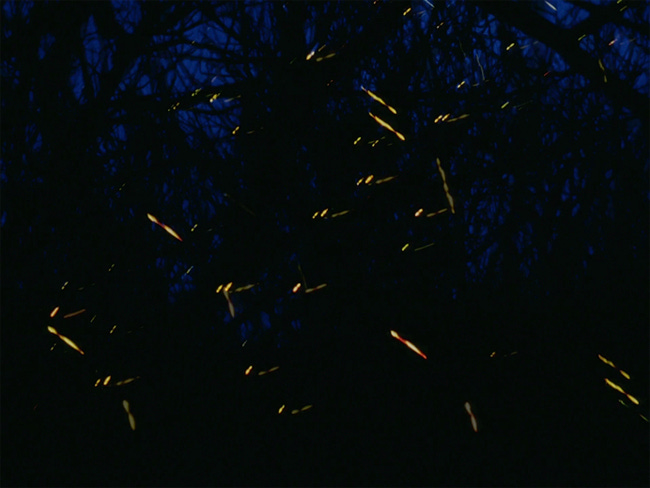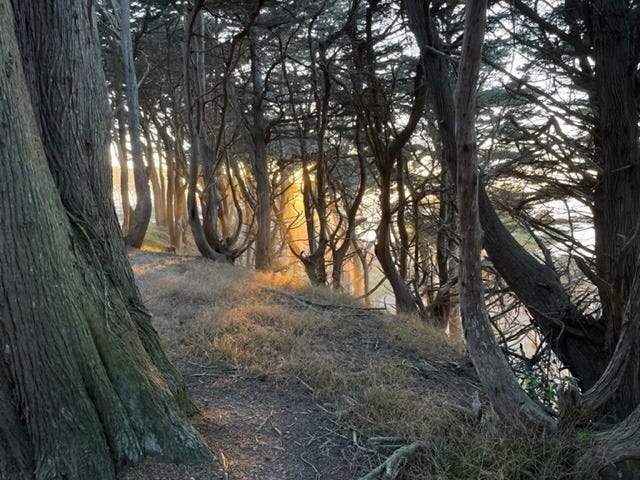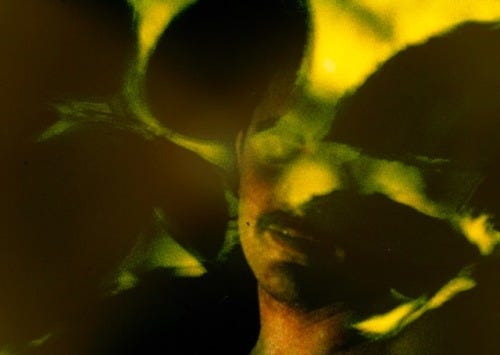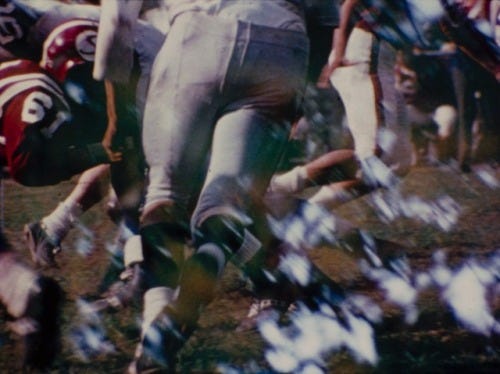Notes on Films by Nathaniel Dorsky and Jerome Hiler (1964-2023) - 1/5
Some words on O Death, Ingreen, A Fall Trip Home, Summerwind, and Words of Mercury
The most exciting Seattle screening series in recent memory celebrated the early films of Nathaniel Dorsky and Jerome Hiler. As romantic partners and fixtures in the underground avant-garde scene in New York, the pair showed their films alongside figures such as Andy Warhol, Stan Brakhage, and Gregory Markopolous. They became pioneers of what Dorsky termed “polyvalent” cinema, cinema that sought to break free of all narrative and thematic concerns, growing organically around color, movement, and texture. For much of the 70s and 80s, Dorsky and Hiler exclusively shot and shared their work in private screenings, first at the “Stone House” in New Jersey, and then in San Francisco, where they relocated in ‘71. Filmed on 16mm Kodachrome at 18fps, the films they produced are ecstatic, physical accounts of their daily lives, reshaping their private existence into emanations from the beyond, and as explained in this blog post, are unavailable in any digital format.
Commemorating the release of a new book about the early cinema of Dorsky and Hiler, PARACME created 5 programs of films by Dorsky and Hiler, including Dorsky’s early works, Dorsky and Hiler’s films utilizing footage from the Stone House and San Francisco, and their most recent works alongside selections from other “experimental” directors with specific resonances to the programs. All presented on 16mm prints, this series represented not only the first time most of these films have ever screened in Seattle, but also, for some of the films such as Dorsky’s Ariel, the last time they would be able to be seen in any capacity.
On a personal level, they’re the first time I’ve been fortunate enough to see experimental film projected. I was able to see major films from Dorsky, whose work I’ve desperately wanted to see for quite some time, and was introduced to Hiler, an even more private filmmaker who only began to distribute his art in the 2010s. More than anything, I was taken by the affective power of their filmmaking, much of which is dedicated the love between partners and to this precious time together in the late 20th century. The screenings were palpably special. More than anything, these notes are for myself to capture my thoughts on these slippery, impermanent films so I can hold onto the experience a bit longer.
Program 1:
I would largely organize this program around texture, introducing Dorsky and Hiler’s work through their intricately designed layers. Was preceded by a short from Sophie Michael, The Watershow Extravaganza, which features a sprinkler show playing classic showtunes in an abandoned space. I liked it well enough. Mostly resonated with the close ups of the water under colored lights that seemed to transform water into sparks. The patterns created by the water, and the ghostly space seemed to be the primary connection.
O Death (Nathaniel Dorsky, 2023):
A film of yellows, browns and blacks. Largely consists of static shots of a woman dressed in black robes behind a lattice of branches. Eventually, we also get a few shots of a wooded trail in the fall/winter. Dorsky adjusts focus and exposure, and the image phases in and out of recognizability. The death is in the cold imagery, the colors, and the stately rhythms. It’s successfully elegiac.
Ingreen (Nathaniel Dorsky, 1964), A Fall Trip Home (Nathaniel Dorsky, 1965), Summerwind (Nathaniel Dorsky, 1966)
An early trilogy of films and the only Dorsky’s we saw with sound. They also heavily feature superimposition. While poetic, these films have recognizable themes.
Ingreen clearly concerns homosexuality. The film’s initial segments superimpose archival footage of a man masturbating and a man lying on his side over imagery of grass. The plant’s connotations of youth eventually lead us into various superimpositions within a family home, where we see a short sequence of a young boy eating a meal with his family. All of these layers eventually play over each other.
My memory of A Fall Trip Home is already limited. It was probably my least favorite of the Dorsky films, but their intricacy also necessitates repeat viewings. My primary recollection is that a huge chunk of the film is spent on a football game superimposed over nature footage. The uniforms are a striking shade of red, echoing the autumnal imagery. The superimpositions and dissolves in all three of films are incredibly dreamy, and have a fairly consistent adagio rhythm. Perhaps my least favorite because it’s the least focused on nature.
Summerwind has a wonderful opening involving water striders. It’s another very green movie. Once again moves away from nature after 4-5 minutes to superimpose a neighborhood parade. Huge shot of the American flag. It’s all vaguely menacing, without ever dipping into outright terror.
These three films showcase Dorsky’s technical ability. The lyrical sensibility is evident. Thought of Davies throughout the entire series, but Dorsky’s work is more materialist and it’s so present. Like some of the other Dorsky films, these three are loosely linked to the seasons. There are a few images from these films that have lodged themselves in my brain, but I can’t recall which film they belong to. There are some beautiful shots in some of these films that observe light hitting a spiderweb. There’s also an image I think is from Ingreen of a man on his knees embracing another man’s legs. I’m ashamed to admit that my memory of the soundtrack is dim. It’s mostly ambient, perhaps some offhand woodwinds? It’s hard to overstate the effect of the silent projection speed. Everything has a slight unreality. I’m curious where all of the archival footage is from.
Words of Mercury (Jerome Hiler, 2011):
One of Hiler’s first distributed works. Begins with one of the most beautiful shots I’ve ever seen, with firefly-lookings lights swarming a dark, nearly pitch black shot of trees. It’s immediately noticeable that Hiler’s work has a different energy. It’s higher frequency. Lighting is obviously so important. One of the most exciting shots is a horizontal tracking shot of a steal beam about a third of the way up from the bottom of the frame. It’s mostly dark, maybe some shades of red, with trees in the background. There’s a bright light hitting the beam and as the camera moves, it glistens like a gemstone or something. It’s blinding and transcendent. The whole film is almost entirely superimpositions, oftentimes all moving in different directions. Dorsky works with focus and exposure, while Hiler’s main tools are movement and superimpositions of light.
This film features a clear musical sensibility, with moments of hypermobility punctuated with static, multilayered but crucially not superimposed shots. One of them is a landscape shot containing a mountain and some evergreen trees under a thick layer of falling rain. Another has a classical Greco-Roman statue placed in an abandoned parking lot. The statue takes up the right side of the frame, while the left is taken up by the many layers of the uncanny location. Dorsky’s images often dissolve/flow into each other. Hiler’s frequently fade to black. I love an image in this film of two dogs running into the ocean. Lots of neon signage in the superimposition as well. Primordial.









